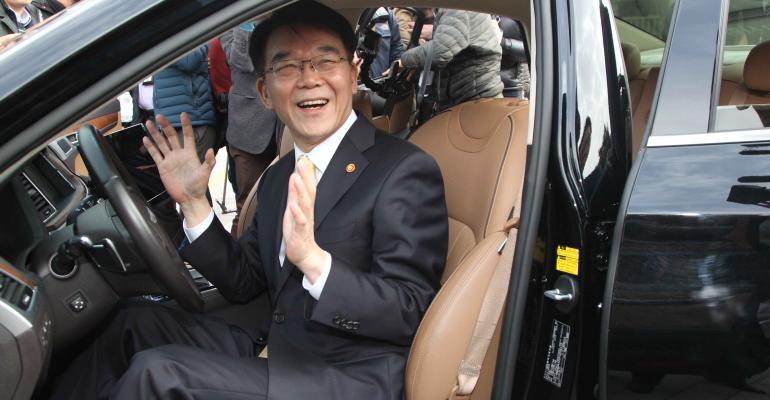Hyundai rounds out its autonomous-car test fleet, getting a 5-year operating license for a self-driving Genesis sedan from Korea’s Ministry of Land, Infrastructure and Transport so it can be driven on designated streets and highways in Korea.
The license for the EQ900 (called the G90 outside Korea) was presented March 7 in Sejong City by Land, Infrastructure and Development Minister Kang Ho-in.
Kang climbed into the back seat of the Genesis Autonomous, as the engineers call it and went on a 4-mile (6.4-km) run over a 2-way 4-lane public road, with the vehicle operating in its fully self-driving mode.
A driver in the front seat was ready to take over from the automatic control system in the event of an emergency. A Hyundai official sat next to Kang in the rear seat.
The 5-year license requires two people to be in the vehicle at all times when it is operating in autonomous mode. One must be ready to override the controls and the other must stay alert for unforeseen traffic conditions that could cause problems.
The license allows testing engineers from the Hyundai-Kia Namyang Technical Center to operate the vehicle for testing purposes on a 25-mile (41-km) stretch of public road in Seoul. The vehicle also can be tested on a total of 198 miles (320 km) of roads on designated sections of five national highways where they run through nine small and medium-size cities.
The locations include the small city of Paju, which is just a few miles from Korea’s Demilitarized Zone.
Kang says he was delighted with the autonomous G90’s performance, which has improved substantially since the last time he rode in a self-driving vehicle at the Namyang center. He promises the ministry will do whatever it can to help Hyundai continue to improve the system so it can be made commercially available as soon as possible.
10-Year Plan
The Namyang center’s target for a commercially available autonomous vehicle is still as far away as 2030. However, the current EQ900 model already is a partially self-driving vehicle. It will be one of the Hyundai vehicles to be commercially available with an advanced semi-autonomous system by 2020.
The Genesis Autonomous is the only such vehicle licensed for testing on public roads in Korea.
Issuance of the license rounds out the three autonomous-vehicle-testing initiatives being directed out of the Namyang center.
In the U.S. the State of Nevada in December issued similar autonomous-vehicle licenses for both a fully autonomous Hyundai Tucson fuel-cell electric vehicle and a Kia Soul self-driving vehicle.
The licenses permit the vehicles to be test-driven on public roads.
Kia exhibited the autonomous system at CES in Las Vegas in January. The system also was a major feature in Kia displays at the Geneva auto show earlier this month, with Kia labeling it the Drive Wise project.
The Namyang center shares its technology with Hyundai and Kia and so both automakers are claiming the same 2 trillion won ($1.65 billion) amount that will be invested to further develop the system through 2018.





